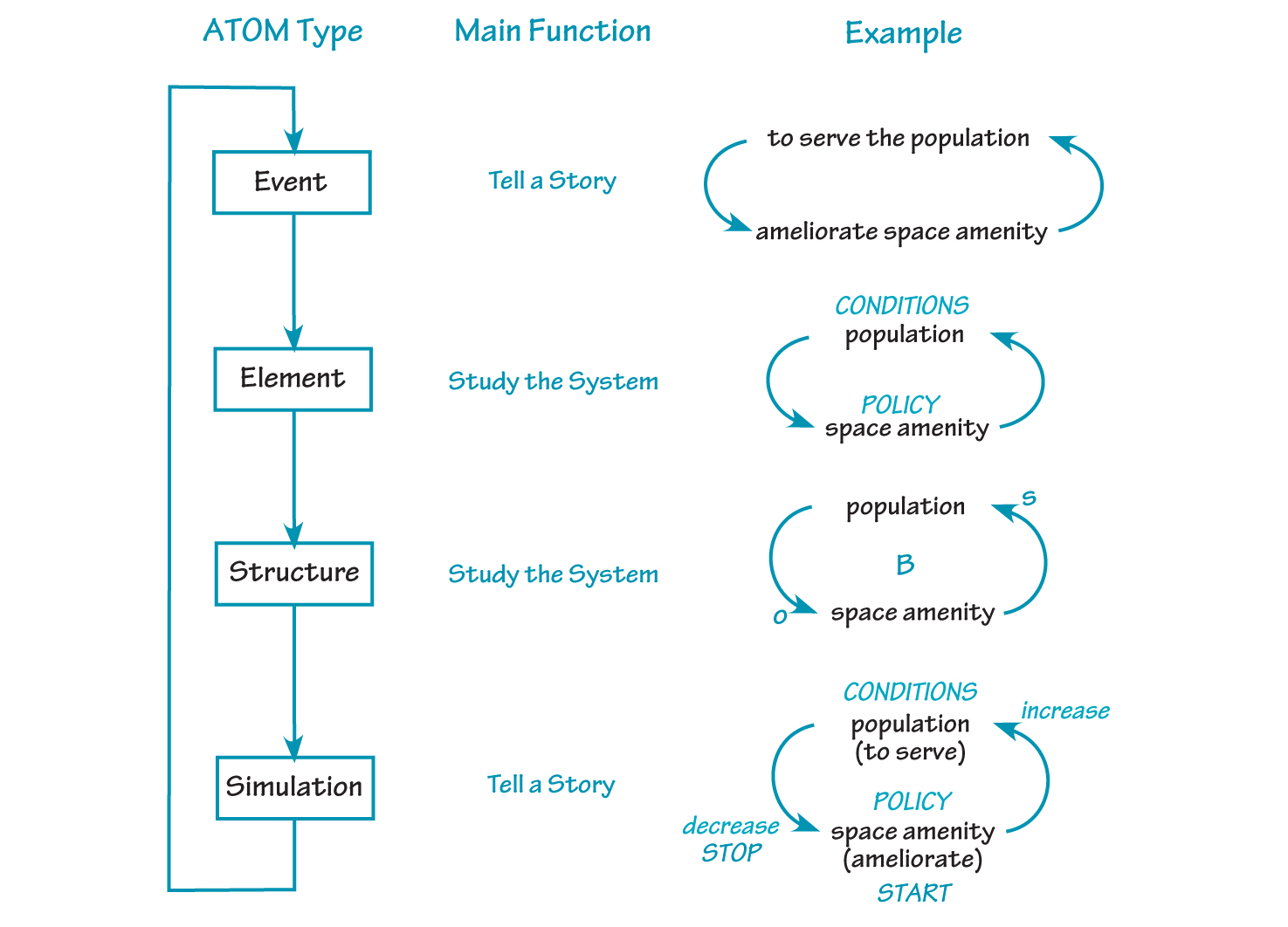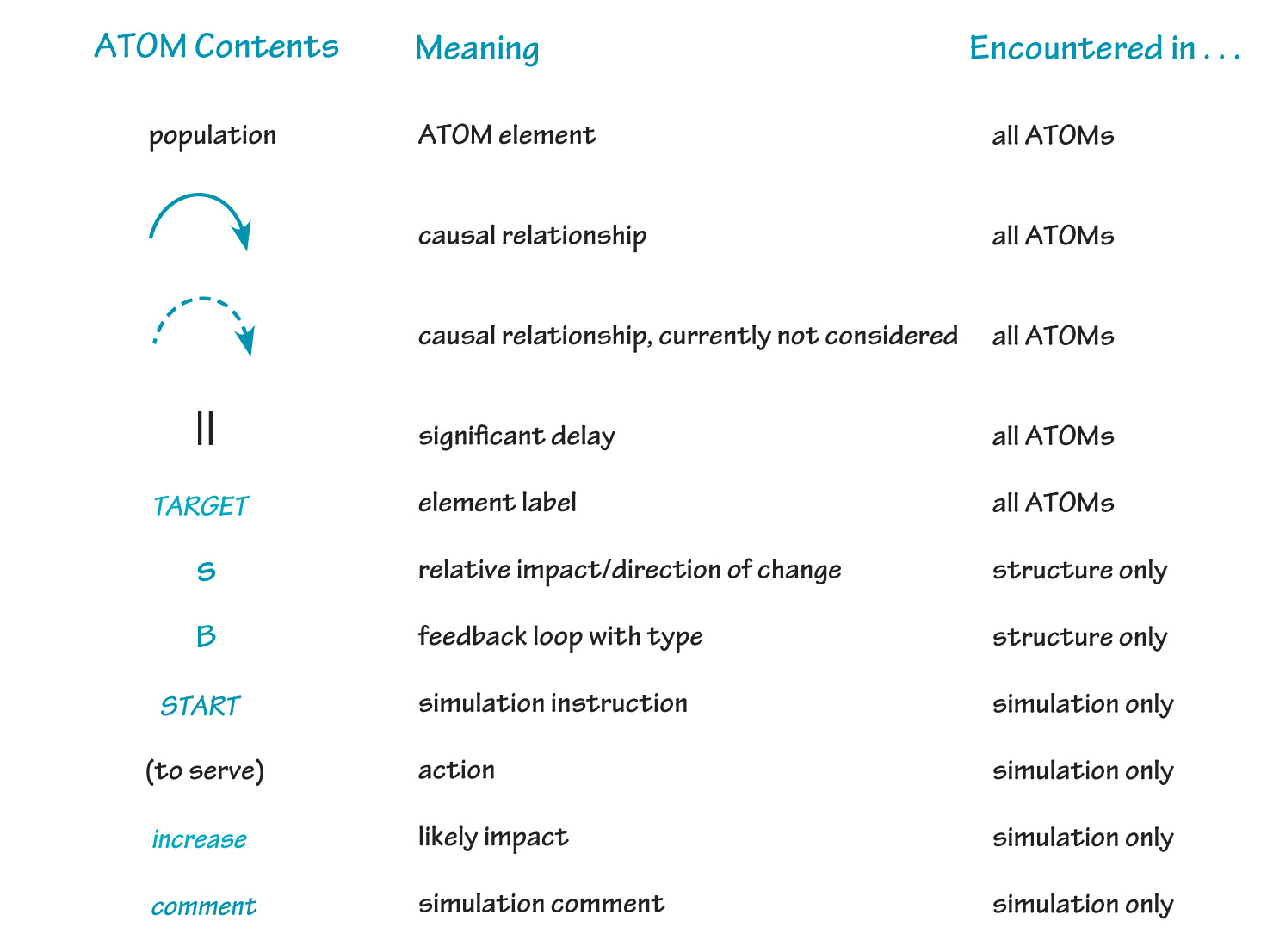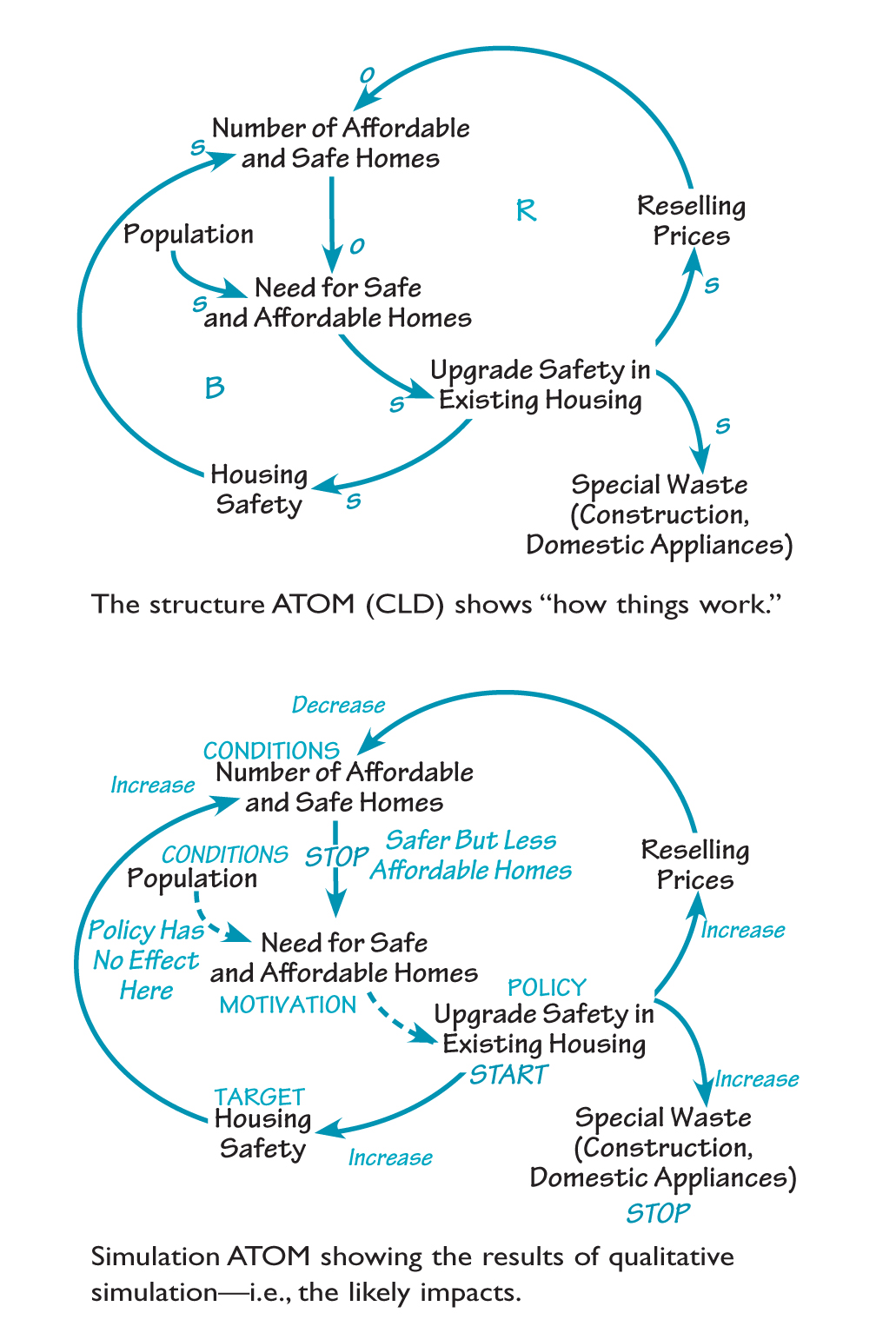During the last few years, our team at the Oxford Institute for Sustainable Development (OISD) has been working on an important but little examined issue of impact assessment: causality. The OISD researches sustainability in built and natural environments at all scales, with the aim of advancing knowledge and practice. Impact assessment is part of the spatial planning, or community development, process concerned with the effects of development proposals on the environment. Causality is a cornerstone to impact assessment, as it associates proposed actions with their likely effects. Consequently, in a chain of events, the quality of causal thinking determines the quality of impact assessment and, eventually, of decision-making.
Action-to-outcome maps (ATOMs), a systems thinking technique developed by Andrew Jones and Don Seville (see “Action-to-Outcome Mapping: Testing Strategy with Systems Thinking” in The Systems Thinker, Vol. 14, No. 2), are useful for handling causality in policy analysis. But impact assessment professionals have been reluctant to use systems thinking tools. Through research, we have documented how practitioners can employ ATOMS to integrate transparent and communicable causal thinking in impact assessment. This article reviews several types of ATOMs, explores their suitability for impact assessment, and presents some illustrations from applications.
TEAM TIP
When planning any kind of strategy or initiative, use systems thinking tools to explore the likely effects of proposed actions. As the authors point out, the quality of causal thinking ultimately determines the quality of decision-making.
Assessing Impact in Proposals
Development proposals range from the operational level, with individual executable projects such as motorways or power stations, to the strategic level, with national or international policy such as land-use plans or climate change mitigation and adaptation strategies. Accordingly, there are various types of impact assessment, including Environmental Impact Assessment (EIA), Strategic Impact Assessment (SEA), and Sustainability Appraisal (SA). The general methodology of impact assessment has been developed and practiced for almost 40 years; the International Association for Impact Assessment, which monitors such practice, has existed for almost three decades.
The typical impact assessment function includes the study of the proposed action, forecast and assessment of the impacts, and proposal for mitigation of the significant adverse impacts. In recent work, we have come to formalize that any analysis of a development proposal for impact assessment purposes must contain four key semantics categories:
System Elements. This is who and what is involved. System elements can be ecosystem components (humans, forest, atmosphere), the actors (construction team, operation team), or the new developments (power station, highway). System elements are usually explicit, but sometimes merely implied.
Action. This is the proposed action. In a proposal, action is expressed by the main “action verbs” (build, operate), and explicitly or implicitly associated to the actors.
Causality. This is how the proposed action will induce certain changes. Causality is expressed by cause-and-effect relationships between system elements; in writing, for instance, causality can be expressed by special verbs (“to cause”).
Impacts or Effects. This is what happens because of the proposed action. Impacts or effects are changes in system elements, such as increase or decrease in magnitude (of noise, of biodiversity).
Representing Causality
The fundamental premise of an impact assessment is a causality statement: the development action causes these impacts. At the operational level of impact assessment — for instance, in Environmental Impact Assessment — causality is concerned with the way impacts arise from the actions of a proposal, directly or indirectly. Impact assessment at the strategic level — for instance in Strategic Environmental Assessment and Sustainability Appraisal — examines the proposals more than the impacts themselves. For instance, compatibility among the objectives becomes an issue, as the interests are likely to be multiple and diverse.
Impact assessment literature does recognize causality as important, and some recommends ways to represent cause-and-effect relationships — although most of these publications are already old. The updating of this literature is difficult without enough examples from practice, as causal thinking is not commonly present in technical reports of impact assessment. With scarce practice and an outdated literature, few are taking the risk or the time to include causality in impact assessment.
Because causality is one of its main concerns, systems thinking has a considerable application potential in impact assessment. Concretely, action-to-outcome maps (ATOMs) of various types are capable of showing explicitly how project action is conceived and assembled to reach its objectives (strategic interest), as well as how it is believed to cause its likely impacts (operational interest).
The first need of impact assessment regarding causality is mostly noted at the operational level, in Environmental Impact Assessment. In a typical impact assessment text, the likely impacts are referred to or simply listed, so causality is not clearly established or demonstrated. Where impact matrices are used, it is easier to tell which actions cause which impacts and vice versa — which impacts arise from each action. However, matrices are not good with cumulative impacts (such as indirect impacts, synergistic effects, additive effects) and cannot show pathways of cause-effect.
Impact assessment of higher-tier proposals, such as plans and programs, may not require very detailed information about impacts. At the strategic level, causality involves the internal qualities of the proposals, such as their coherence and completeness. To date, this concern manifests itself mainly through compatibility matrices, which juxtapose the proposal’s objectives in order to expose any conflicts. In addition to the compatibility concern, other causality issues on the action side may include the nexus between objectives and action, logical gaps, dead-ends, and island effects (for instance, isolated objectives or action).
Review of Systems Thinking Tools
In the past, we have tried to apply standard diagramming techniques from systems thinking, such as causal loop diagrams (CLD) and stock and flow diagrams (SFD), to satisfy the causality needs of impact assessment both at the operational and the strategic level. These techniques have proven unpopular among specialist colleagues. At informal talks in meetings of the International Association of Impact Assessment, some practitioners have reported that they “have tried [SFDs] with no particular success”; others, more practical, urge to “keep it simple”; some complain that [CLDs] are “too technical”; and strong skeptics admit that they “don’t see the importance of all this.”
SIMULATION ATOM

Simulation ATOMs look like CLDs, but instead of relative effects (or relationship types) they show likely effects—i.e., the results of a simulation.
Causal Loop Diagrams. In particular, causal loop diagrams contain rich and useful information about the causal relationships, and can also help determine and label feedback loops. However, CLDs appear to deter many impact assessment professionals because of the “+/− or “s/o” (, “same”/ “opposite”) symbols next to the arrowheads, and the “balancing” and “reinforcing” labeling of the feedback loops. After experimenting with CLDs, we saw that the impact assessment professionals were right to complain, not because CLDs were “too technical” or “too complicated,” but because they do not give them what they want to know — impacts. The types of relationships within pairs of variables shown in CLDs are in essence relative impacts; that is, when a relationship between A and B is marked as “s,” an increase in A will produce an increase in B, and/or a decrease in A will produce a decrease in B. What impact assessment professionals really want to see are the likely impacts — that is, what is likely to happen to B in this case—will it increase or decrease? This kind of analysis is difficult to depict with CLDs.
Stock and Flow Diagrams. Environmental impact studies occasionally include numerical simulation on things such as noise, air pollution, and water pollution. Even though we have not come across numerical simulation methods based on stock and flow diagrams in Environmental Impact Statements, SFDs could very well be used in advanced forecasting. But they would not appear in the main body of the EIS, where everything must be kept accessible to all readers.
Impact assessment professionals generally have strong negative reactions to experimentations with stock and flow diagrams. This may be because they are made up of special shapes like rectangles, flows, arrows, and clouds. Also, although stocks and flows can provide numerical forecasts, impact assessment professionals don’t view that capacity favorably, perhaps because they are used to working with other tools.
Action-to-Outcome Maps.The causality diagrams that have occasionally appeared in technical reports of EIAs and SEA/SAs are quite informal when contrasted with CLDs and SFDs. Such informal diagrams typically employ text boxes and arrows. The arrows indicate causal links more or less as in CLDs, while the boxed text may be as simple as mere system elements (such as “water quality”) or events (such as “reduction in willingness to use alternatives”). What we call Element ATOMs are like CLDs, and their simplicity in content helps practitioners to clearly see what is involved in the system. Event ATOMs tell stories in a user-friendly, step-by-step, “if-then” fashion, making them particularly good for transcribing plans and programs into diagrammatic form.
ATOM TYPES AND FUNCTIONS

To serve the causality needs of impact assessment at both the strategic and operational levels, we devised a new systems thinking tool specially made for impact assessment: simulation ATOMs (see “Simulation ATOM”). Simulation ATOMs are designed to present simulation results — that is, likely impacts — for impact assessment purposes. To keep them simple and accessible, we create simulation ATOMs in open-source vector diagramming software (OpenOffice.org Draw). The simulation is qualitative and “manual” — that is, created by hand — as opposed to the typical numerical/automated simulation produced by software based on stocks and flows.
EXPLANATORY KEY

From the previous section, we distinguish four types of ATOMs suitable for use in impact assessment (see “ATOM Types and Functions”):
Event ATOMs. They contain a combination of system elements and action, using regular expressions; they tell a story easily and understandably with “if-then” statements; historically, they have appeared as informal diagrams in SEA/SAs; they are valuable in transcribing policy from text to diagrams.
Element ATOMs. They contain system elements and their basic links (typically as unmarked arrows); they are useful for studying what is involved in a system (related to a story); historically, they have been used as incomplete or “draft” versions of CLDs; being free of scenarios, they can be used to define objectives and seek alternative action; they can be formed by abstracting “if-then” ATOMs, removing any policy element.
Structure ATOMs. They contain system elements and their basic links, plus relation symbols (s/o), feedback, delays, etc.; they are useful for studying what is involved in a story and in which functional way (system structure and function); historically, they have been the typical, all-purpose CLDs.
Simulation ATOMs. They contain system elements and action, plus simulation results; they are useful for presenting simulation results, such as impacts; they tell a complete story; they are a new type of ATOM, for the purposes of EIA and related applications; during simulation, it is easy to capture faults in thought such as dead-ends, isolated action or objectives (islands), inefficient or fragile long-winded paths, and logic errors.
Since there are various types of ATOMs to serve different purposes, each one should include an explanatory key (see “Explanatory Key”).
Application Examples
Operational Level. We created three ATOMs based on an Environmental Impact Statement of a single project in a European Union member state in the 1990s. Two types of ATOMs helped to discover information faults in the EIS, which could have been avoided or corrected at a pre-production stage.
We first transcribed the EIS information into the simplest form of ATOMs: an element ATOM. Because the document used verbs such as “causes,” causality was almost always unambiguous, but sometimes information was missing about certain causal relationships. The information provided in the EIS was mainly about the likely impacts, so we proceeded to create the simulation ATOM. The impacts in the causal relationships were typically reported as “increase” or “decrease,” but sometimes impacts were reported merely as a “change.”
SAMPLE ATOMS

From the described behavior in the simulation ATOM, we discovered the types of causal relationships in the system. Although we were able to identify some feedback loops, most of them could not be labeled because some information was missing — for instance, one of the causal relationships in the loop was not possible to identify because there was uncertainty in the impact. In this case, we did not create an event ATOM because the information in the EIS was not presented in a suitable way, and the event ATOM would not add any new value to the analysis.
Strategic Level. In the case of a community development plan of a local authority of a European Union member state, all four types of ATOMs, in their own ways, helped to surface information faults that could have been avoided or corrected at a preproduction stage. We started by creating the event ATOM from the text of the plan. Since the plan contained complete information about objectives, targets, guidelines, and action, we were then able to produce an element ATOM, discover the structure ATOM, and finally create a simulation ATOM from the plan’s single action scenario. The four ATOMs gave various indications that the plan was not yet ready for implementation. For instance, some guidelines were “islands,” not being connected to anything else (for example, guideline 4h: cater for the ageing and less mobile citizens). Some actions were missing between guidelines and goals (for example, guideline 4g: promote safe housing → [new action: upgrade safety in existing housing] → goal 4g: raise standard in housing safety). Finally, some goals could be confused as action, since they contained “action verbs” (for example, goal 4g: raise standard in housing safety). “Sample ATOMS” illustrates a section of two ATOMs from this case study.
Discussion and Conclusion
Systems thinking makes a valuable contribution to the handling of causality for impact assessment through four types of qualitative action-to-outcome maps. Event ATOMS are useful for transcribing plans and programs, telling a simple story, and catching basic mistakes in the conception of strategy; however, they are insufficient for finer detail in the exploration of strategy, or simulating and presenting impacts. Element ATOMs are essential for clarifying the picture painted by event ATOMs, and also for discovering and marking the roles of the system elements. Structure ATOMs (classic CLDs) aid in exploring how the system works, which is necessary for the refinement of the proposed action. Finally, simulation ATOMs (a new type of systems thinking diagram) tell a story much better than event ATOMs, catch finer mistakes in the conception of strategy, and present qualitative forecasts suitably for the needs of impact assessment. Whether in training or production circumstances, all ATOMs—and especially simulation ATOMs—offer value to the impact assessment process and to the professionals involved.
Anastássios Perdicoúlis (tasso@utad.pt) is a Visiting Research Fellow at the Oxford Institute for Sustainable Development and Assistant Professor at the Universide de Trás-os-Montes e Alto Douro in Portugal. John Glasson (jglasson@brookes.ac.uk) is Professor of Environmental Planning at the School of the Built Environment and Co-Director of the Oxford Institute for Sustainable Development.
